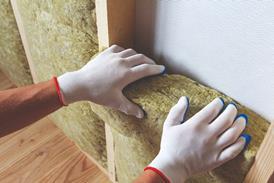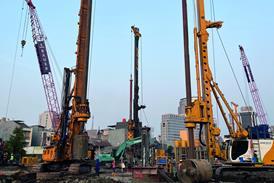This is where MK Electric's test facility is based. Inside is not what you'd expect either. It all seems a bit antiquated. Big wooden schoolroom science lab desks stand in a row. Technicians in white coats pore over their work and along one wall is a huge bank of test modules, looking like the set of Star Trek – those with Captain Kirk in.
It isn't until Dave Carr, facility manager, explains what happens here that I really grasp the importance of this industrial unit. "This is where all of MK's products are tested. Tested to meet British Standards, and beyond." The Star Trek set is actually 19 test modules hooked up to integral pcs. Here plugs, sockets and switches are tested for BS compliance. First up is the socket endurance test. It is operating as we approach. A metal arm holding a plug methodically pushes it in to a socket making an electrical connection, then extracts it again. It does this 15 000 times. Every connection is recorded.
The modules also do switch testing. A robotic finger flicks a white moulded light switch on, off, on, off, 30 000 times. "These are the BS tests," explains Carr. "We can test dimmer switches and pull cords on here, too." Results recorded from these test modules include the product's operation, temperature rises, the make and break capacity of an electrical connection: everything that could be faulty.
Next I am led into a room behind the Star Trek modules. It is filled with masses of fluorescent tubes, connected in banks of 24. There are nearly 300 tubes in total. These produce an inductive load when testing the switches. 54 tubes are needed to test one 10 A switch.
New standards will soon replace the room of tubes with a small piece of equipment; a simulated fluorescent load network. Carr thinks that the old test is actually better at putting switches through their paces but in order to comply he'll use the new test.
Next, I am led to the inner sanctum, off the main lab. A fume cupboard dominates one wall. A mini intergalactic transporter, I wonder? It is used for the glow wire tests. An element is heated to between 650 and 9607C and products are held against it to test their insulative value – does the product re-ignite once the element is removed? The tests are extremely rigorous on all products and components within. MK actually develops and carries out its own tests on products in order to be confident of its guarantees, some up to 20 years.
Some tests involve complicated equipment and procedures such as environmental chambers where products are heated and frozen for hours, then struck to test for brittleness. Others are simple; a cloth doused with abrasive fluid is rubbed repeatedly on a switchplate to test for wear and scratch resistance; brass socket plates are left in wet plaster to discover whether tarnishing occurs.
Selling products into different global climates is also taken into account. Salt sprays are played over products for two hours before they are heated to 407C at 93% humidity for 22 hours. Once passed the products can be sold in the Far East.
To ensure that the correct regimes are being adhered to, MK's facility is accredited yearly by UKAS. "Quite a stressful time," says Carr, "but the standards that MK work to are accepted as being among the best in the world." MK and its test facility are producing products that are suitable for use anywhere in the world. In fact, as James T Kirk once said: "Our mission is to take MK where no plugs or sockets have gone before. Space the final frontier."
Socket money
The days of under-socketed homes could be short-lived according to research commissioned by Hager. The study, carried out for Hager‘s Ashley wiring accessories brand, finds that 82% of contractors and wholesalers in the survey believe that new houses will have more sockets installed in them in the next five years. The research also predicts more switches (according to 74% of respondents) and more spur units (73%). Such progress is expected to be gradual, however, with 62% of those surveyed expecting an increase in demand for sockets in the next 12 months and 59% expecting an increase in switches and spur units. The marketplace also suffers from lack of choice. As many as 60% of contractors felt that homeowners should be given more choice in wiring accessories when buying a new home. When purchasing wiring accessories, Hager's survey revealed that contractors put quality and reliability foremost, with two-thirds expecting a guarantee of greater than five years and nearly half wanting at least a ten-year guarantee. Other key factors were (in order): safety, availability, price and ease of installation.Source
Electrical and Mechanical Contractor



















